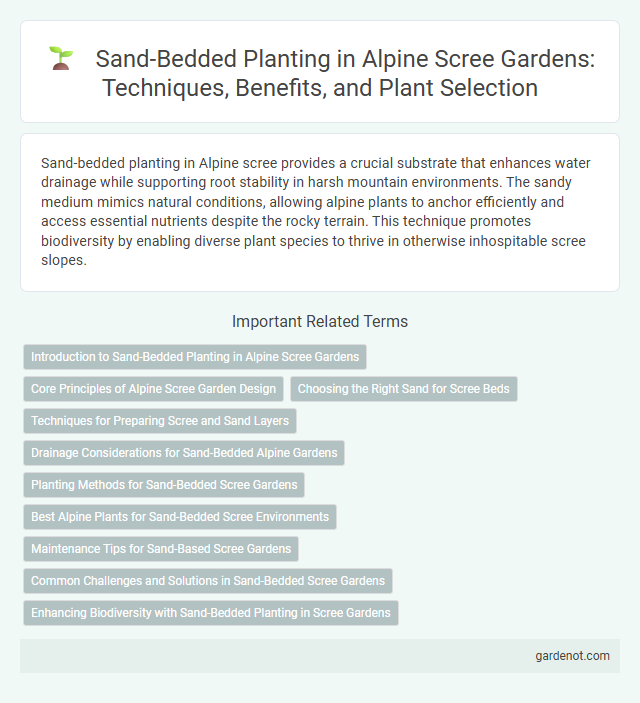Sand-bedded planting in Alpine scree provides a crucial substrate that enhances water drainage while supporting root stability in harsh mountain environments. The sandy medium mimics natural conditions, allowing alpine plants to anchor efficiently and access essential nutrients despite the rocky terrain. This technique promotes biodiversity by enabling diverse plant species to thrive in otherwise inhospitable scree slopes.
Introduction to Sand-Bedded Planting in Alpine Scree Gardens
Sand-bedded planting in alpine scree gardens involves creating a specialized substrate composed primarily of coarse sand to mimic the natural drainage and aeration conditions of mountainous scree environments. This method supports the growth of alpine plants by providing excellent water drainage, reducing root rot risks, and promoting healthy root development in species adapted to nutrient-poor, rocky soils. Incorporating sand beds with appropriate plant selection ensures a stable, sustainable habitat for alpine flora, enhancing biodiversity and garden resilience.
Core Principles of Alpine Scree Garden Design
Sand-bedded planting in alpine scree gardens emphasizes excellent drainage and mimics natural mountain habitats by using coarse sand layers to prevent waterlogging and root rot. This technique supports the growth of drought-tolerant, low-nutrient-demanding alpine species by replicating their native scree environment through a well-draining substrate. Effective sand-bedded planting balances moisture retention and aeration, ensuring optimal root health and plant stability within the gravelly, rocky matrix of the scree garden.
Choosing the Right Sand for Scree Beds
Selecting the right sand for alpine scree beds is crucial to ensure optimal drainage and root aeration, with coarse, well-draining sand such as quartz or silica sand being ideal. The sand should have a balanced grain size, avoiding fine particles that can retain excessive moisture and promote root rot in scree plants. Proper sand composition supports the natural habitat of alpine species, enhancing plant health and stability in harsh, rocky environments.
Techniques for Preparing Scree and Sand Layers
Preparing alpine scree for sand-bedded planting involves layering coarse sand over well-draining scree to mimic natural alpine conditions. Techniques include ensuring a gradient of particle sizes for optimal drainage and stability, and incorporating organic matter sparingly to promote root anchorage without compromising aeration. Proper layering supports moisture retention while preventing waterlogging, essential for hardy alpine species.
Drainage Considerations for Sand-Bedded Alpine Gardens
Sand-bedded planting in alpine scree requires excellent drainage to prevent waterlogging and root rot in sensitive plants. Using coarse sand ensures rapid water percolation while maintaining sufficient moisture retention for alpine species. Effective drainage management optimizes plant health and mimics natural alpine scree conditions.
Planting Methods for Sand-Bedded Scree Gardens
Sand-bedded scree gardens require precise planting methods to ensure root stability and optimal drainage. Plants should be placed in individual sand pockets with ample spacing to mimic natural scree conditions, allowing for air circulation and minimizing water retention. Using a combination of native alpine species adapted to well-drained, sandy substrates enhances plant establishment and long-term growth success.
Best Alpine Plants for Sand-Bedded Scree Environments
Best alpine plants for sand-bedded scree environments include Sedum acre, Androsace septentrionalis, and Draba aizoides, known for their drought tolerance and adaptability to well-drained, sandy soils. These species exhibit low-growing, mat-forming habits that stabilize loose scree and enhance soil retention. Their resilience to temperature fluctuations and poor nutrient availability makes them ideal candidates for sustainable scree landscaping.
Maintenance Tips for Sand-Based Scree Gardens
Regularly monitor the sand bed for erosion and replenish with coarse, well-draining sand to preserve optimal root aeration and moisture levels. Remove weeds promptly to reduce competition for nutrients and maintain the garden's delicate balance. Ensure proper drainage by checking for water pooling, which can cause root rot in alpine scree plants adapted to sandy substrates.
Common Challenges and Solutions in Sand-Bedded Scree Gardens
Sand-bedded scree gardens often face challenges such as poor water retention, nutrient leaching, and instability of plant anchorage, which can hinder root development and plant survival. To address these issues, incorporating organic matter or high-quality compost into the sand improves moisture retention and nutrient availability, while using stabilizing materials like coarse gravel or biodegradable netting helps secure plants in place. Selecting drought-tolerant, deep-rooting alpine species further enhances resilience by optimizing water absorption and anchorage in the loose substrate.
Enhancing Biodiversity with Sand-Bedded Planting in Scree Gardens
Sand-bedded planting in alpine scree gardens creates ideal microhabitats that support diverse plant species adapted to well-drained, nutrient-poor conditions. This method enhances biodiversity by mimicking natural scree substrates, promoting root aeration and moisture regulation essential for specialized flora such as Saxifraga and Sedum species. Integrating sand-beds increases ecological resilience, supporting pollinators and microorganisms that contribute to a balanced scree ecosystem.
Sand-bedded planting Infographic

 gardenot.com
gardenot.com